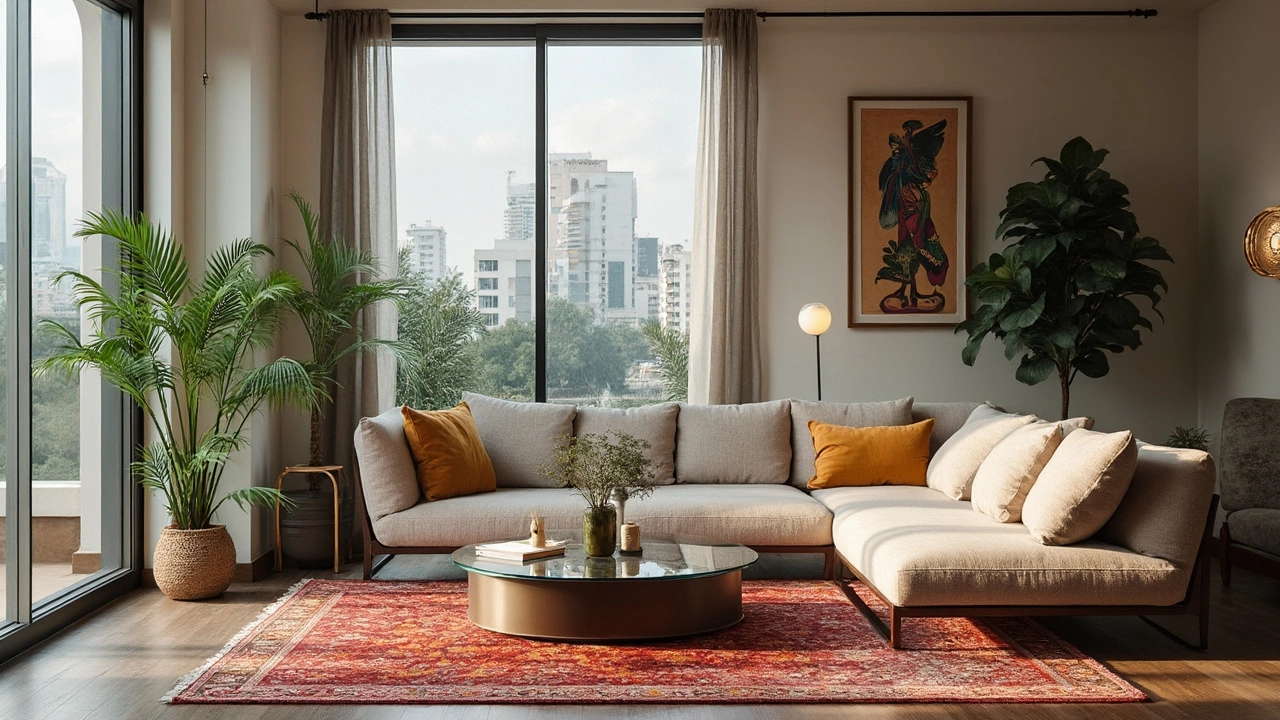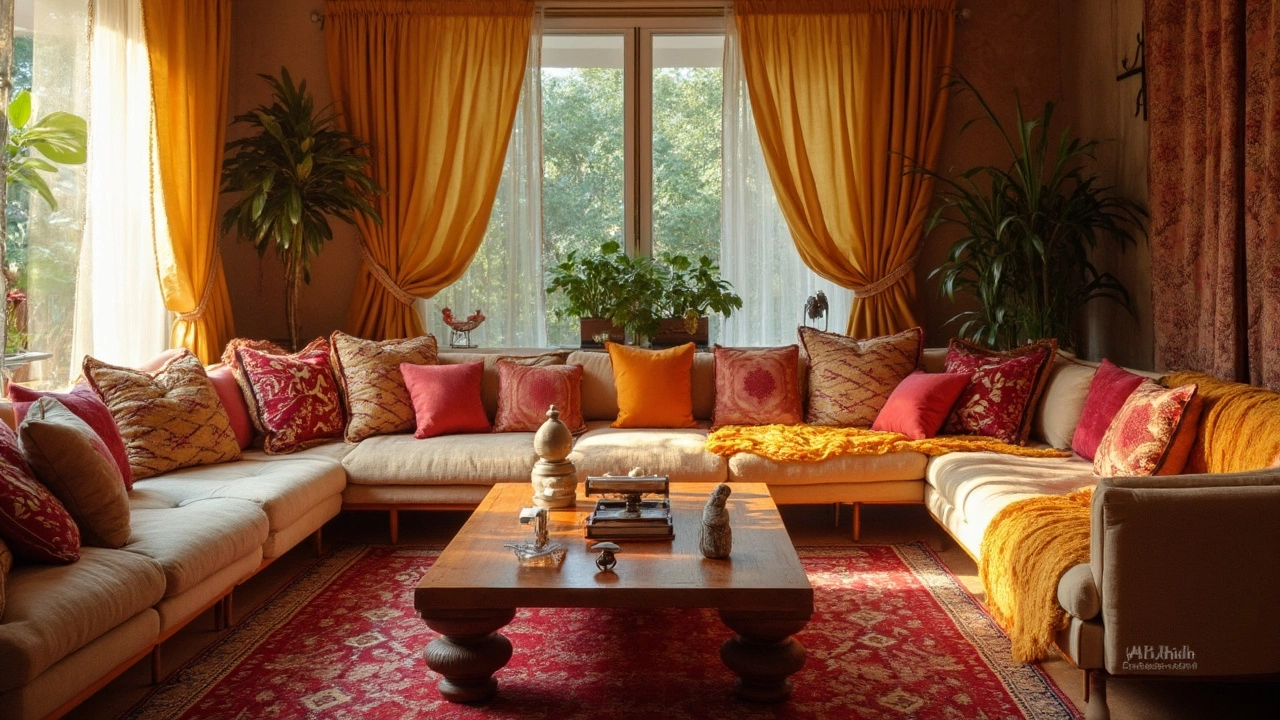Ever bumped your knee on the coffee table while reaching for the TV remote? Yeah, we've all been there. Getting the right distance between your couch and coffee table isn't just about aesthetics—it's about making life easier.
So, how far apart should these two pieces really be? Generally, a sweet spot lies between 14 to 18 inches. Close enough to put your feet up if you're that kind of person, yet far enough to avoid any painful encounters. This keeps everything within arm's reach while still allowing room to stretch comfortably.
Of course, this isn't a one-size-fits-all kind of thing. Your living room layout, the size of your furniture, and even personal habits play a big role here. Stay tuned to find out how to tweak this distance for a cozier, more practical space.
- Why Distance Matters
- General Guidelines for Spacing
- Adjusting for Room Size
- Working with Different Table Shapes
- Considerations for Accessibility
- Style Tips to Enhance Your Setup
Why Distance Matters
Let's dive into the nitty-gritty of why a comfy gap between your couch and coffee table is super important. It's all about practicality and your daily comfort.
Avoiding Accidents
No one likes bruised shins. A well-planned distance helps avoid clumsy moments. Ever caught your pet satellite-dishing your coffee mug across the room? The right spacing can prevent accidental kicks and spills.
Ensuring Easy Access
Reaching for your cup of joe or that must-have snack should be easy. When the gap isn't just right, you might find yourself stretching awkwardly. For most people, a comfortable stretch is around 16 inches. This ensures you can grab what you need without doing a mini workout.
Maintaining Traffic Flow
Traffic jams aren't just for roads—they happen in the living room too. Keeping open pathways makes your home feel less cramped, especially when you've got company over.
Enhancing Seating Comfort
Adjusting foot space is key for loungers who love to kick back. Whether placing feet up is your style or not, getting this distance right improves the lounging experience. A comfy setup often means happier, more relaxed TV nights.
Consideration for Room Size
It's not only about the table and couch combo but also how it fits in your room. Keeping a balance maintains the room's aesthetics and functionality, offering a clear line of sight and a sense of openness.
| Recommended Distance (inches) | Reason |
|---|---|
| 14-18 | General recommendation for easy reach and comfort |
General Guidelines for Spacing
Setting up your living room furniture can feel like solving a puzzle. The trick with the coffee table and couch is to find a balance between comfort and flow.
Standard Measurements
Generally, the ideal distance falls between 14 to 18 inches from the front of the couch to the edge of the coffee table. This range is practical for most average-sized living rooms. It allows you to stretch out without knocking over your drink.
Account for Walkways
If your coffee table sits in a path where people walk through, like between the couch and a TV or another room, you might need a little more space. Adding a few extra inches ensures that nobody trips or bumps into the table.
Room Size Considerations
In a small room, you might need to opt for a smaller table or slightly adjust your spacing closer to 14 inches to avoid a cramped feeling. For larger rooms, the upper end of 18 inches, or even a touch more, can keep things from feeling too sparse.
| Room Size | Suggested Distance |
|---|---|
| Small | 12-14 inches |
| Medium | 14-18 inches |
| Large | 18-24 inches |
Remember, the perfect distance is as much about personal comfort as it is about sticking to guidelines. Feel free to test by moving things around and see what feels right for you.
Adjusting for Room Size
Getting the right distance between your coffee table and couch can hugely depend on your room size. In a spacious living area, you might have the luxury to experiment a bit more with layouts. But in cozier spaces, precision is key.
Smaller Rooms
If your living room is on the smaller side, space is precious. Here, the minimum 14-inch distance can be your safest bet. Keeping things snug yet functional avoids the cramped feeling. Try opting for a smaller, round table. It can make moving around easier without sacrificing style.
Larger Rooms
In larger rooms, the challenge is filling the space without clutter. You're free to push that distance up to 18 inches, or even slightly more, without disrupting the flow. Consider adding an area rug that connects the couch and coffee table, anchoring the space visually.
According to interior designer Sarah Knight, "Understanding your space's dimensions lets you make the most of what's there, ensuring comfort and accessibility without compromising on style."
"Design should be both inviting and practical. Knowing how to balance elements in your living room—like the right distance between a couch and coffee table—creates a welcoming atmosphere that's also functional." – Sarah Knight, Interior Designer
Being mindful of your room's scale helps maintain balance. Say goodbye to those awkward furniture gaps or overly tight squeezes. Whether it's a sprawling open-plan area or a snug city apartment, the trick lies in observing the room's layout and playing with the recommended distances.

Working with Different Table Shapes
Choosing the right coffee table shape can impact everything from your living room's functionality to its overall style. Your choice should complement not just the couch but the entire space.
Round Tables
Round tables are great when you’ve got kids running around, since they don’t have any sharp corners. They fit well in smaller spaces, offering a cozy feel without looking cramped. An ideal distance here might lean towards the lower end of the spectrum—around 14 inches—allowing for easy access all around the table.
Rectangular and Oval Tables
If your room has a larger footprint, rectangular and oval tables work wonders. These are classics for a reason—they're versatile and can accommodate a coffee table book or tray without overwhelming the space. Aim for a distance of about 16 to 18 inches. This keeps the area open yet functional.
"The choice of a coffee table shape can redefine your living area's dynamic, especially when paired with the right distance," says interior designer, Sarah Greensmith.
Square Tables
Square tables fit perfectly in a small, symmetrical seating area. They provide an even surface area that's great for board games or dinner by the TV. Ensure there’s enough space to walk around comfortably—keeping that 16 to 18-inch rule in mind.
| Shape | Ideal Distance |
|---|---|
| Round | 14-16 inches |
| Rectangular | 16-18 inches |
| Square | 16-18 inches |
Remember, when picking a coffee table, consider how you and your family use the space. Whether it’s for entertaining guests or just kicking back, ensure your setup works for everyone.
Considerations for Accessibility
When setting up your living room, it's crucial to be mindful of accessibility. This makes sure everyone, including folks who might use a wheelchair or have mobility challenges, can move around easily and safely.
Space for Mobility
Think about the space needed for someone to comfortably navigate between the couch and the coffee table. Aim for a minimum pathway of 30 to 36 inches. This ensures that whether you're maneuvering a wheelchair or carrying a tray of snacks, you won't find yourself in a tight squeeze.
Table Height and Reach
Avoid placing the coffee table too high or too low. Ideally, it should be about the same height as your couch seat, which is typically 16 to 18 inches off the floor. This way, reaching for that mug of coffee or a bowl of popcorn doesn't feel like a workout.
Edge and Corner Safety
Think about the corners of your coffee table. Rounded edges can prevent nasty bruises if you accidentally bump into them. If your table is rectangular or square with sharp corners, placing corner guards might be a good idea, especially if kids or older adults are frequent visitors.
Visual and Physical Space
Everyone loves a good open feel in their room. One easy trick is to choose a glass-top coffee table. It maintains the airy vibe while still serving its purpose. Plus, it helps the room look bigger, which can be a win if space is limited.
Caring for your living room’s accessibility doesn’t just enhance comfort; it creates a welcoming environment for everyone. Paying attention to these little details might just prevent a lot of unnecessary hassle and keep the space inviting and user-friendly.
Style Tips to Enhance Your Setup
Your living room isn't just a place to crash after a long day. It's a reflection of your style and your escape at home. So, nailing the setup around your coffee table and couch not only boosts functionality but also ups the cool factor.
Play with Shapes and Sizes
The shape of your coffee table can dramatically change the vibe of your room. Got a squarish or rectangular room? Try a round or oval table to soften edges and create flow. Smaller space? Go for a nesting table that you can tuck away when needed.
Color Coordination
Match or contrast your table with the rest of your living room. A wooden table pairs well with earthy tones and gives a warm, cohesive look. Glass or metallic tables can add a modern touch, creating a hint of luxury.
Add Functional Accessories
Don't let your coffee table be just about style. Throw some chic storage solutions in the mix. A decorative box or basket can keep remotes and knick-knacks out of sight but still easily accessible.
- Add a tray to group items and make it look less cluttered.
- Use books for height variation—stack them and place a candle or small plant on top.
Lighting Matters
A well-lit room not only makes it feel more open but can serve as a design feature. Add a floor lamp nearby or even a couple of table lamps to create cozy pockets of light.
Mix Materials
Mixing materials like metal, wood, and glass in your furniture layout can break monotony and add interest. Think a wooden base with a glass top or metal legs for that industrial chic look.
Let Your Personality Shine
Ultimately, your space should feel like you. Throw in personal touches like keepsakes, framed photos, or unique art pieces to give it character. Remember, the best style tip is to make a space you enjoy spending time in.

